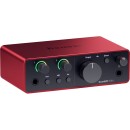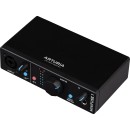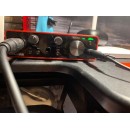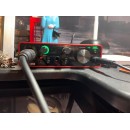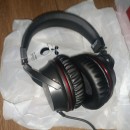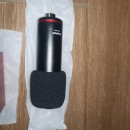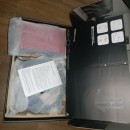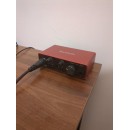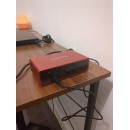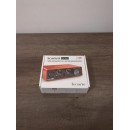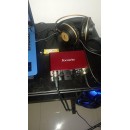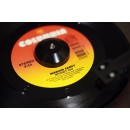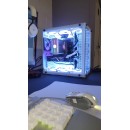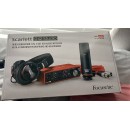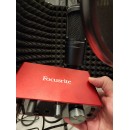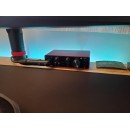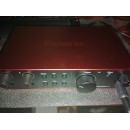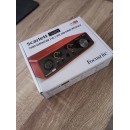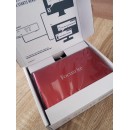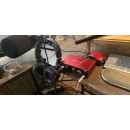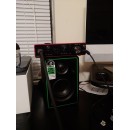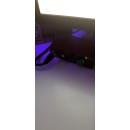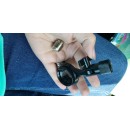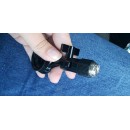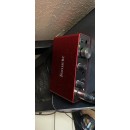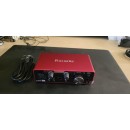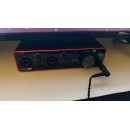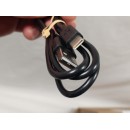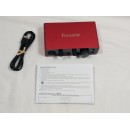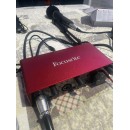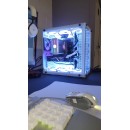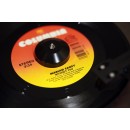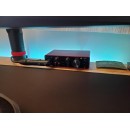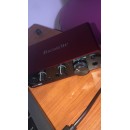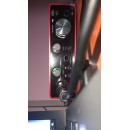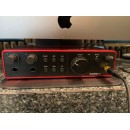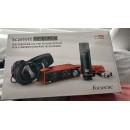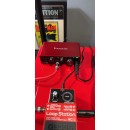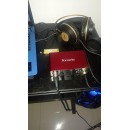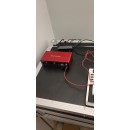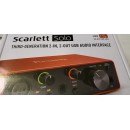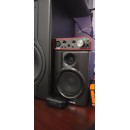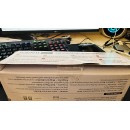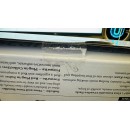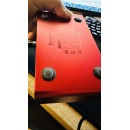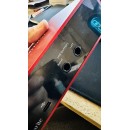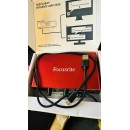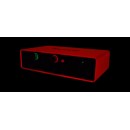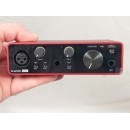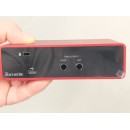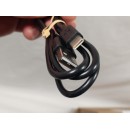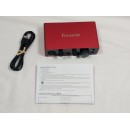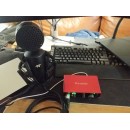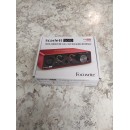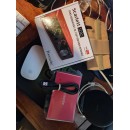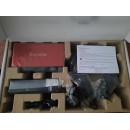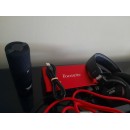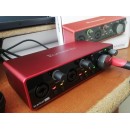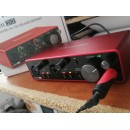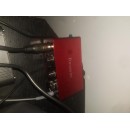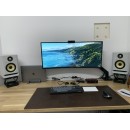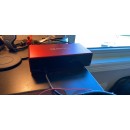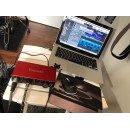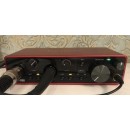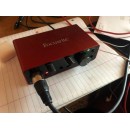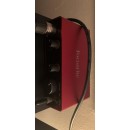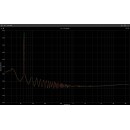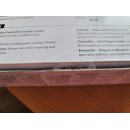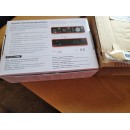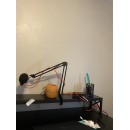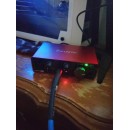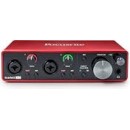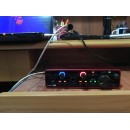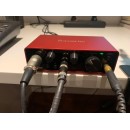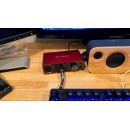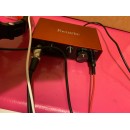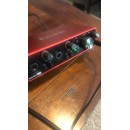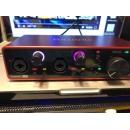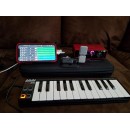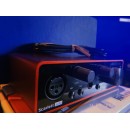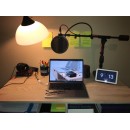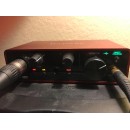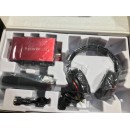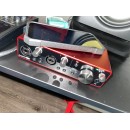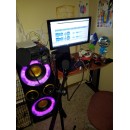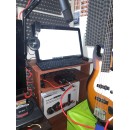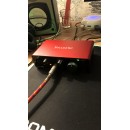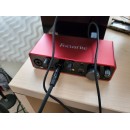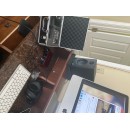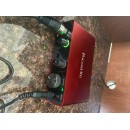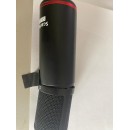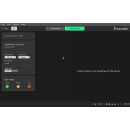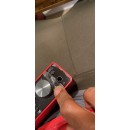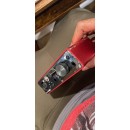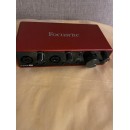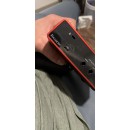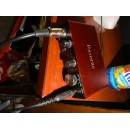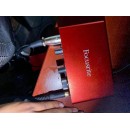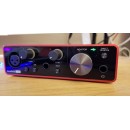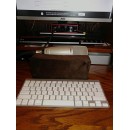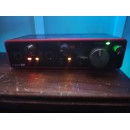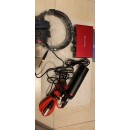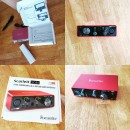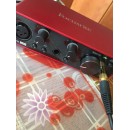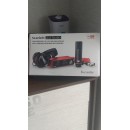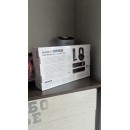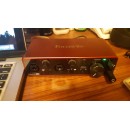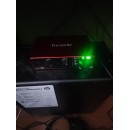Arturia MiniFuse 1 vs Focusrite Scarlett Solo 4th Gen: A Detailed Comparison
The Arturia MiniFuse 1 and the Focusrite Scarlett Solo (4th Generation) are both highly regarded interfaces in the realm of USB Type-C audio interfaces, each catering to different needs and preferences of musicians, podcasters, and producers. Starting with the design aspect, the Arturia MiniFuse 1 is known for its compact and sleek design, making it exceptionally portable and easy to integrate into any workspace. It boasts a single combo input that supports both microphone and instrument-level signals, and it features a robust build quality that ensures durability.
On the other hand, the Focusrite Scarlett Solo (4th Generation) also offers a compact and stylish design but takes a slightly different approach with its iconic red casing. It features one XLR mic input and one high-headroom instrument input. This interface is particularly popular for its high-quality preamps that deliver a clean and natural sound, making it a preferred choice for vocal and guitar recordings. The third generation of Scarlett interfaces is known for its improved preamp technology, and the fourth generation continues to build on this reputation with even better audio fidelity.
In terms of performance, the Arturia MiniFuse 1 provides a remarkable 110dB dynamic range and ultra-low noise, ensuring pristine audio quality. It also comes bundled with a comprehensive software suite, including Arturia's own creative software instruments, which is a significant advantage for those looking to expand their music production toolkit. Meanwhile, the Focusrite Scarlett Solo is equipped with a 24-bit/192kHz audio resolution, offering professional-grade sound quality. It also comes with a generous software bundle that includes Ableton Live Lite, Focusrite’s Red Plug-in Suite, and more, providing a solid foundation for music production and recording.
Both interfaces feature USB Type-C connectivity, ensuring fast and reliable connection with modern devices. The Arturia MiniFuse 1 is celebrated for its straightforward functionality and is particularly appealing to those who prioritize portability and simplicity in their recording setup. The Focusrite Scarlett Solo, with its enhanced preamps and slightly more advanced features, is ideal for users who demand high-quality recordings and are perhaps more focused on capturing vocals and instruments with exceptional clarity.
In this section, we will delve into a detailed comparison of the Arturia MiniFuse 1 Portable 1x2 USB Type-C Audio Interface and the Focusrite Scarlett Solo USB-C Audio Interface (4th Generation). We will explore their specifications, highlighting the unique features, strengths, and potential drawbacks of each product. Our comprehensive review aims to provide you with all the information needed to make an informed decision between these two popular audio interfaces.
Specifications, Advantages, and Disadvantages
| User Rating Based on Analysis of Reviews | |
|---|---|
|
Show More |
| Pros: | |
|---|---|
|
|
| Cons: | |
|---|---|
|
|
| Find Best Price | Find Best Price |
| Key Specs | |
|---|---|
| Channels of I/O | |
| Analog: 2 Inputs / 2 Outputs at 192 kHz |
Analog: 1 Input / 2 Outputs |
| Maximum Sampling Rate | |
| 192 kHz / 24-Bit | 192 kHz / 24-Bit |
| Number of Microphone Inputs | |
| 1 | 1 Preamp |
| Analog Audio I/O | |
| 1x XLR 3-Pin Balanced Mic Input 1x 1/4" TS Unbalanced Line/Hi-Z Input (Front Panel) 2x 1/4" TRS Balanced Monitor Output 1x 1/4" TRS Headphone Output (Front Panel) |
1x Combo XLR-1/4" TRS Balanced/Unbalanced Mic/Line/Hi-Z Input (Front Panel) 2x 1/4" TRS Balanced Line Output 1x 1/4" TRS Unbalanced Headphone Output (Front Panel) |
| Host Connection | |
| 1x USB-C | 1x USB-C |
| OS Compatibility | |
| macOS Windows |
macOS Windows |
| Power Requirements | |
| USB Bus Power, USB Power Adapter (Not Included) | USB Bus Power |
When comparing the Arturia MiniFuse 1 and the Focusrite Scarlett Solo USB-C Audio Interfaces, both devices offer impressive specifications suitable for various recording needs. The Arturia MiniFuse 1 features a 1 Input / 2 Outputs configuration, while the Focusrite Scarlett Solo provides a slightly more versatile 2 Inputs / 2 Outputs setup. Both interfaces support a maximum sampling rate of 192 kHz / 24-Bit, ensuring high-quality audio capture and playback.Show More
In terms of microphone inputs, both interfaces come equipped with 1 Microphone Preamp. The Arturia MiniFuse 1 includes a 1x Combo XLR-1/4" TRS Balanced/Unbalanced Mic/Line/Hi-Z Input, while the Scarlett Solo features a 1x XLR 3-Pin Balanced Mic Input and a 1/4" TS Unbalanced Line/Hi-Z Input. This gives the Scarlett Solo a slight edge in flexibility for connecting different types of sources, including instruments.
Regarding output options, the Arturia MiniFuse 1 offers 2x 1/4" TRS Balanced Line Outputs and a 1/4" TRS Unbalanced Headphone Output, while the Scarlett Solo provides 2x 1/4" TRS Balanced Monitor Outputs and a 1/4" TRS Headphone Output. Both interfaces utilize a USB-C connection for host compatibility and are designed to work seamlessly with macOS and Windows operating systems.
Power requirements for both devices are satisfied through USB Bus Power, although the Scarlett Solo also offers the option for a USB Power Adapter (not included), providing additional flexibility in powering the device. Overall, both the Arturia MiniFuse 1 and Focusrite Scarlett Solo present strong features that cater to different user needs, with the Scarlett Solo providing a more extensive input configuration while the MiniFuse 1 focuses on portability and simplicity.
| General | |
|---|---|
| Channels of I/O | |
| Analog: 2 Inputs / 2 Outputs at 192 kHz |
Analog: 1 Input / 2 Outputs |
| Maximum Sampling Rate | |
| 192 kHz / 24-Bit | 192 kHz / 24-Bit |
| Number of Microphone Inputs | |
| 1 | 1 Preamp |
| Input Level Adjustment | |
| 2x Knob | 1x Knob |
| Expansion Slots | |
The Arturia MiniFuse 1 is a portable 1x2 USB Type-C audio interface that offers 1 input and 2 outputs. It supports a maximum sampling rate of 192 kHz with a bit depth of 24-bit. This interface is designed with a single microphone preamp, allowing for straightforward recording tasks. The input level adjustment is simplified with 1 knob, making it user-friendly for those who prefer a minimalist setup.Show More
On the other hand, the Focusrite Scarlett Solo USB-C Audio Interface (4th Generation) provides a slightly more versatile configuration with 2 inputs and 2 outputs, while also supporting a maximum sampling rate of 192 kHz and 24-bit depth. Similar to the MiniFuse, it includes 1 microphone input but stands out with its 2 knobs for input level adjustments, allowing for more precise control over both input channels. However, it does not feature built-in DSP or expansion slots.
In summary, both audio interfaces offer high-quality audio performance with a maximum sampling rate of 192 kHz and 24-bit depth. The Arturia MiniFuse 1 is tailored for users who require a simple, portable solution with a single input, while the Focusrite Scarlett Solo appeals to those looking for more input flexibility with its 2 inputs and 2 outputs, accompanied by additional control through 2 knobs for level adjustments.
| Signal Processing | |
|---|---|
| Gain/Trim Range | |
| Mic/Line Inputs: Up to +69 dB Hi-Z Inputs: 62 dB |
Mic/Line/Hi-Z Inputs: 56 dB |
The Arturia MiniFuse 1 is designed as a portable 1x2 USB Type-C audio interface, featuring a gain/trim range of 56 dB for its mic, line, and Hi-Z inputs. However, it does not include a pad option, high-pass filter, or solo/mute functionality, which may limit its versatility in certain recording scenarios. This design choice may appeal to users looking for a straightforward interface without additional complexities.Show More
In contrast, the Focusrite Scarlett Solo USB-C Audio Interface (4th Generation) boasts a more robust gain/trim range, offering up to +69 dB for mic/line inputs and 62 dB for Hi-Z inputs. This greater range allows for more flexibility and control over the recording levels, which can be particularly beneficial for capturing a diverse array of sound sources. The Scarlett Solo also lacks a pad option but compensates with its higher gain capabilities, making it suitable for a wider range of microphones and instruments.
Overall, while the Arturia MiniFuse 1 serves as a compact and simple audio interface, the Focusrite Scarlett Solo offers enhanced gain options, making it a more versatile choice for users requiring greater control over their recordings. The selection between these two interfaces will largely depend on the specific needs of the user and the types of recordings they intend to make.
| Connectivity | |
|---|---|
| Analog Audio I/O | |
| 1x XLR 3-Pin Balanced Mic Input 1x 1/4" TS Unbalanced Line/Hi-Z Input (Front Panel) 2x 1/4" TRS Balanced Monitor Output 1x 1/4" TRS Headphone Output (Front Panel) |
1x Combo XLR-1/4" TRS Balanced/Unbalanced Mic/Line/Hi-Z Input (Front Panel) 2x 1/4" TRS Balanced Line Output 1x 1/4" TRS Unbalanced Headphone Output (Front Panel) |
| Phantom Power | |
| 48 V, Selectable On/Off | 48 V, Selectable On/Off |
| Digital Audio I/O | |
| Host Connection | |
| 1x USB-C | 1x USB-C |
| Host Connection Protocol | |
| USB 2.0 | USB 2.0 |
| USB (Non-Host) | |
| 1x USB-A (USB 2.0, Device Connection) | |
| Sync I/O | |
| Network I/O | |
| MIDI I/O | |
The Arturia MiniFuse 1 and Focusrite Scarlett Solo (4th Generation) are both compact USB-C audio interfaces designed for musicians and podcasters seeking high-quality audio recording. The MiniFuse 1 features a 1x Combo XLR-1/4" TRS Balanced/Unbalanced Mic/Line/Hi-Z Input on the front panel, while the Scarlett Solo offers a 1x XLR 3-Pin Balanced Mic Input and a 1/4" TS Unbalanced Line/Hi-Z Input. Both interfaces support 48 V phantom power that can be selected on or off, catering to condenser microphones.Show More
In terms of output options, the MiniFuse 1 includes 2x 1/4" TRS Balanced Line Outputs and a 1/4" TRS Unbalanced Headphone Output, while the Scarlett Solo provides 2x 1/4" TRS Balanced Monitor Outputs and a 1/4" TRS Headphone Output. This gives the MiniFuse a slight edge in flexibility with its additional line outputs, which can be beneficial for connecting to various monitoring systems.
Both devices utilize USB-C connections and support USB 2.0 protocol, making them compatible with most modern computers. However, the MiniFuse 1 features a USB-A port for device connection, allowing for additional connectivity options. In contrast, the Scarlett Solo does not offer a USB (Non-Host) connection. Neither interface includes digital audio I/O, sync I/O, network I/O, or MIDI I/O, making them straightforward solutions for basic audio recording needs.
In summary, the Arturia MiniFuse 1 stands out with its additional output options and USB connectivity, while the Focusrite Scarlett Solo remains a solid choice for those prioritizing simplicity and quality in a compact package. Both interfaces are designed to deliver excellent audio performance, catering to different user preferences and recording scenarios.
| Performance | |
|---|---|
| Frequency Response | |
| XLR Mic Inputs: 20 Hz to 20 kHz ±0.06 dB 1/4" Line Inputs: 20 Hz to 20 kHz 0.05 dB 1/4" Hi-Z Inputs: 20 Hz to 20 kHz 0.15 dB |
Mic Inputs: 20 Hz to 20 kHz ±0.06 dB (Min Gain) Hi-Z Inputs: 20 Hz to 20 kHz ±0.06 dB (Min Gain) Line Inputs: 20 Hz to 20 kHz ±0.05 dB (Min Gain) Line Outputs: 20 Hz to 20 kHz ±0.09 dB Headphone Outputs: 20 Hz to 20 kHz ±0.09 dB |
| Maximum Input Level | |
| XLR Mic: 9.5 dBu 1/4" Line: 22 dBu 1/4" Hi-Z: 12 dBu |
Mic Inputs: +9 dBu Hi-Z Inputs: +11.5 dBu Line Inputs: +22 dBu |
| Maximum Output Level | |
| 1/4" Line: +16 dBu |
Line Outputs: +12 dBu Headphone Outputs: +11.4 dBu |
| Headphone Output Power | |
| 1/4": 32 mW into 33 Ohms 22 mW into 300 Ohms |
137 mW into 33 Ohms |
| Impedance | |
| XLR Mic Inputs: 3 Kilohms 1/4" Line Inputs: 60 Kilohms 1/4" Hi-Z Inputs: 1 Megohms 1/4" Line Outputs: 200 Ohms 1/4" Headphone Outputs: < 50 Ohm |
Mic Inputs: 2.5 Kilohms Hi-Z Inputs: 1 Megohm Line Inputs: 16 Kilohms Line Outputs: 94 Ohms Headphone Outputs: 10 Ohms |
| Dynamic Range | |
| XLR Mic Inputs: 113 dBA 1/4" Line Inputs: 113 dBA 1/4" Hi-Z Inputs: 112 dBA 1/4" Line Outputs: 120 dB 1/4" Headphone: 112 dB (at 33 Ohms) 115 dB (at 300 Ohms) Digital A/D Converters: 120 dB Digital D/A Converters: 130 dBA |
Mic/Line/Hi-Z Inputs: 110 dB (A-Weighted) Line Outputs: 107.5 dB (A-Weighted) Headphone Outputs: 104 dB (A-Weighted) |
| THD+N | |
| XLR Mic Inputs: -100 dB (at Minimum Gain) 1/4" Line Inputs: -100 dB (at 8 dB Gain) 1/4" Hi-Z Inputs: -80 dB (at Minimum Gain) 1/4" Line Outputs: -100 dB (at Minimum Gain) 1/4" Headphone Outputs: -97 dB (at 33 Ohms) -102 dB (at 300 Ohms) Digital A/D Converters: -110 dB Digital D/A Converters: -115 dB |
Mic Inputs: -100 dB (Unweighted, 1 kHz, Typical) Hi-Z Inputs: -91 dB (Unweighted, 1 kHz, Typical) Line Inputs: -100 dB (Unweighted, 1 kHz, Typical) Line Outputs: -101 dB (Unweighted, 1 kHz, Typical) |
| EIN | |
| XLR Mic Inputs: -127 dBu A-Weighted |
Mic Inputs: -129 dB A-Weighted |
When comparing the Arturia MiniFuse 1 and the Focusrite Scarlett Solo (4th Generation), both audio interfaces offer impressive specifications, yet they cater to slightly different needs in terms of performance. The Arturia MiniFuse 1 features a frequency response for mic, Hi-Z, and line inputs ranging from 20 Hz to 20 kHz with minimal gain variations, while the Scarlett Solo also shares a similar frequency response, ensuring high fidelity in audio capture.Show More
In terms of maximum input levels, the MiniFuse 1 supports mic inputs at +9 dBu, Hi-Z inputs at +11.5 dBu, and line inputs at +22 dBu. The Scarlett Solo, on the other hand, has slightly different parameters with its XLR mic input at +9.5 dBu, Hi-Z input at +12 dBu, and line input also at +22 dBu. This means the MiniFuse 1 has a marginally better Hi-Z input level, which may be beneficial for guitarists or those using high-impedance instruments.
When considering maximum output levels, the MiniFuse 1 provides line outputs at +12 dBu and headphone outputs at +11.4 dBu. In contrast, the Scarlett Solo boasts a higher line output level of +16 dBu, which may allow for a stronger signal to external devices. Additionally, the headphone output power of the MiniFuse 1 is rated at 137 mW into 33 Ohms, compared to the Scarlett Solo's 32 mW into 33 Ohms, making the MiniFuse a more powerful option for headphone monitoring.
In terms of dynamics and noise performance, the MiniFuse 1 shows a dynamic range of 110 dB for mic, line, and Hi-Z inputs, while the Scarlett Solo achieves a slightly higher dynamic range of 113 dBA for its mic inputs. The THD+N specifications also reveal that both interfaces excel in low distortion, with the MiniFuse 1 showing -100 dB for mic inputs and the Scarlett Solo matching that at -100 dB for its XLR mic inputs, showcasing their capabilities in delivering clean audio signals.
Lastly, when evaluating electrical noise (EIN), the MiniFuse 1 has a lower noise floor at -129 dB for mic inputs compared to the Scarlett Solo's -127 dBu. This indicates that the MiniFuse 1 might be slightly more favorable for capturing quiet sources without introducing additional noise. Overall, both interfaces present excellent features, yet the choice ultimately depends on individual needs regarding input sensitivity, output levels, and power for monitoring.
| Digital Audio | |
|---|---|
| Sample Rates | |
| 44.1 / 48 / 88.2 / 96 / 176.4 / 192 kHz | 44.1 / 48 / 88.2 / 96 / 176.4 / 192 kHz |
| Bit Depths | |
| 24-Bit | 24-Bit |
| Sync Sources | |
| Internal | Internal |
The Arturia MiniFuse 1 and the Focusrite Scarlett Solo (4th Generation) both offer impressive specifications, particularly in terms of sample rates and bit depths. Both interfaces support a range of sample rates including 44.1, 48, 88.2, 96, 176.4, and 192 kHz, ensuring high-quality audio capture and playback. Additionally, they both operate at a bit depth of 24-Bit, which is essential for professional audio production.Show More
One key difference between the two models is the latency management. The Arturia MiniFuse 1 provides Zero-Latency Direct Monitoring, allowing users to hear their input signal without any delay, which can be crucial during recording sessions. The Focusrite Scarlett Solo, while also featuring internal sync sources, does not specifically mention zero-latency monitoring, which may be a consideration for users prioritizing real-time audio feedback.
In terms of synchronization, both devices utilize internal sync sources, which ensures stable audio performance. This feature is standard across many audio interfaces and is important for maintaining timing accuracy during recordings. Overall, while both the Arturia MiniFuse 1 and the Focusrite Scarlett Solo 4th Generation share many core features, the MiniFuse's direct monitoring capability could provide an edge for users who need immediate audio response during their sessions.
| Audio Storage & Playback |
|---|
| Compatibility | |
|---|---|
| OS Compatibility | |
| macOS Windows |
macOS Windows |
The Arturia MiniFuse 1 Portable 1x2 USB Type-C Audio Interface is designed for seamless integration with both macOS and Windows operating systems. It requires an available USB 2.0 port and comes with a USB cable included. However, it is important to note that an internet connection is required for registration, software, and driver download, which may be a consideration for users with limited connectivity.Show More
In contrast, the Focusrite Scarlett Solo USB-C Audio Interface (4th Generation) also supports macOS and Windows compatibility. A notable feature of this interface is its mobile app compatibility, specifically for iPadOS only, which provides additional versatility for users who prefer to work on mobile devices. This can enhance workflow for musicians and producers who are frequently on the move.
Ultimately, both interfaces offer robust performance and compatibility with popular operating systems. The Arturia MiniFuse 1 emphasizes its portability and the requirement for an internet connection for initial setup, while the Focusrite Scarlett Solo enhances its appeal with mobile app support for iPadOS. Users should evaluate their specific needs and usage scenarios when choosing between these two audio interfaces.
| Power | |
|---|---|
| Power Requirements | |
| USB Bus Power, USB Power Adapter (Not Included) | USB Bus Power |
The Arturia MiniFuse 1 is designed for portability and convenience, relying solely on USB Bus Power for operation. This makes it an excellent choice for musicians and podcasters who need to record on the go without the hassle of carrying extra power supplies. The simplicity of its power requirements allows for a streamlined setup, perfect for mobile recording scenarios.Show More
In contrast, the Focusrite Scarlett Solo USB-C Audio Interface (4th Generation) also operates on USB Bus Power but offers the additional option of using a USB Power Adapter (not included) for enhanced flexibility. This means users can power the device via a standard AC/DC power adapter rated at 5 VDC at 900 mA, which can be particularly useful in studio settings where reliable power is essential. The added capability allows for a more robust power consumption of 4.5 W, ensuring stable performance during lengthy recording sessions.
Overall, while both interfaces prioritize portability with their USB Bus Power capabilities, the Focusrite Scarlett Solo provides a more versatile power solution that can be advantageous for those needing consistent power in various environments. Meanwhile, the Arturia MiniFuse 1 excels in keeping things lightweight and uncomplicated for mobile use.
| Physical | |
|---|---|
| Dimensions | |
| 5.63 x 3.78 x 1.79" / 14.3 x 9.6 x 4.55 cm | 5.9 x 3.9 x 1.6" / 15 x 9.9 x 4.1 cm |
| Weight | |
| 0.8 lb / 363.0 g | 0.9 lb / 0.4 kg |
When comparing the Arturia MiniFuse 1 and the Focusrite Scarlett Solo USB-C Audio Interface (4th Generation), it is essential to note the physical dimensions and weight of each device. The Arturia MiniFuse 1 measures 5.9 x 3.9 x 1.6 inches (15 x 9.9 x 4.1 cm) and weighs 0.9 lb (0.4 kg), making it slightly larger and heavier than its competitor. In contrast, the Focusrite Scarlett Solo has dimensions of 5.63 x 3.78 x 1.79 inches (14.3 x 9.6 x 4.55 cm) and a weight of 0.8 lb (363.0 g), which renders it more compact and lightweight.Show More
Another notable feature of the Arturia MiniFuse 1 is its Kensington Security Slot, providing an added layer of security for users who may need to safeguard their equipment in shared or public spaces. This feature is absent in the Focusrite Scarlett Solo, which may be a consideration for users prioritizing device security.
In summary, while both audio interfaces are designed for portability, the Arturia MiniFuse 1 offers a Kensington Security Slot, which enhances its security profile. However, the Focusrite Scarlett Solo is slightly smaller and lighter, potentially making it a more convenient choice for users seeking a compact solution.
| Packaging Info | |
|---|---|
| Package Weight | |
| 1.305 lb | 1.025 lb |
| Box Dimensions (LxWxH) | |
| 7.2 x 6.1 x 2.5" | 6.9 x 5.3 x 1.9" |
The Arturia MiniFuse 1 is a compact and lightweight audio interface, with a package weight of 1.025 lb and box dimensions measuring 6.9 x 5.3 x 1.9 inches. This makes it an ideal choice for musicians and podcasters who require portability without sacrificing functionality. Its small size allows for easy transport, making it suitable for on-the-go recording sessions.Show More
In contrast, the Focusrite Scarlett Solo (4th Generation) weighs 1.305 lb and comes in a slightly larger package with dimensions of 7.2 x 6.1 x 2.5 inches. While still relatively portable, it is marginally heavier and bulkier compared to the MiniFuse 1. This may be a consideration for users who prioritize a lightweight setup.
Overall, while both audio interfaces offer quality performance, the Arturia MiniFuse 1 stands out for its lighter weight and more compact dimensions, making it a preferable option for those who travel frequently with their gear. The Focusrite Scarlett Solo, while a bit larger and heavier, still remains a solid choice for those who may value its specific features or brand reputation over portability.
| Customer Images | |
|---|---|
| Videos | |
|---|---|
|
|
|
